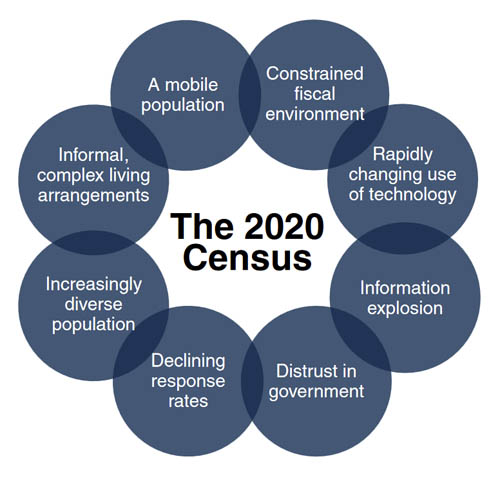 In a year, households across Minnesota and the U.S. will be asked to fill out a Census 2020 form.
In a year, households across Minnesota and the U.S. will be asked to fill out a Census 2020 form.
At stake is the number of representatives each state will get in Congress, and distribution of billions of dollars to states and within states for the upcoming decade.
The biggest change in the next census is that 75% to 80% of households will be invited to fill out their form online. The rest will get the traditional printed form.
The Minnesota State Demographic Center is gearing up to ensure the biggest possible participation in the upcoming census. The Metropolitan Council is leading some technical and geographic tasks in the seven-county metro region. What are known as Complete Count Committees have an important role to encourage participation in the census at the local level.
How census data is used
A decennial (every 10 years) census is called for in the U.S. Constitution, as is the apportionment of Congressional representatives based on the census. In 2010, Minnesota would have lost its eighth congressional seat had about 8,700 fewer people filled out their forms, according to Andrew Virden, director of operations and engagement for the State Demographer’s office. In 2020, the eighth congressional seat is again at stake.
 The federal government also uses census data to determine, at least in part, distribution of federal funds to the states, explained Todd Graham, research analyst for the Council. For example, Minnesota has about 2% of the U.S. population, and receives about 2% of federal highway planning and construction dollars.
The federal government also uses census data to determine, at least in part, distribution of federal funds to the states, explained Todd Graham, research analyst for the Council. For example, Minnesota has about 2% of the U.S. population, and receives about 2% of federal highway planning and construction dollars.
In addition, the Council’s forecasts and annual population estimates are all based on and benchmarked to the previous census, Graham said. And those estimates become the basis for distribution of local streets aid and local government aid from the state, for example.
Census data also informs both government and private sector planning decisions and provides base data for a great variety of public and private research.
Challenges in the 2020 Census cycle
 Graham said that the 2020 Census cycle faces some historically new challenges. These include:
Graham said that the 2020 Census cycle faces some historically new challenges. These include:
-
Streamlined processes of address canvassing and field follow-up for nonresponses, using “big data” to determine locations that are probably vacant and don’t need follow-up visits.
-
Introduction of widespread internet response. This is a massive undertaking, Graham said, and will need a website and servers able to handle the load. The user experience will need to be simple enough that people have patience to get through all 11 questions.
-
A new question on citizenship will be perceived as threatening or intimidating and will depress participation or completion of questionnaires, according to professional associations that represent demographers and government statisticians.
-
The Census Bureau’s brand and public goodwill are deteriorating as a result of the citizenship question debate, Graham said. The success of the census relies on community partners and their volunteer time. Some community organizations that have promoted the census in the past may not be willing this time around, because of statements they’ve heard coming out of Washington.
-
Virden said that often people do not understand that census data is completely confidential to the Census Bureau and is not shared with other agencies or disclosed to the public as individual data for 72 years. “Answering the census is safe,” he said.
Council’s role in the census
In the past, the Council has engaged with the Census Bureau to improve the spatial geographic data the bureau has for our region. That has led to increased precision and reliability of the data, Graham said. The Council also has helped to validate and redraw statistical boundaries, such as census tracts (not to be confused with political district boundaries, which are revised through other processes).
The Council is also a State Data Center member. We provide expertise, training and extension of census data so that the public can access and use it, Graham said.
For the upcoming census, the Council:
-
Provided counties and cities with its latest regionwide parcels and address data to help validate and update the Census Bureau’s address list.
-
Will review and update the boundaries of census tracts and block groups for the seven-county metro area that the U.S. Census Bureau will use from 2020 to 2029. Local elected officials, neighborhood and district councils, nonprofits and other groups that use census data can have input on the 2020 tracts and block groups through April.
-
Co-convenes quarterly meetings of the Metro Local Governments Roundtable on 2020 Census. Local government staff exchange ideas about promoting awareness and participation in the 2020 Census, sharing best practices and experience.
-
Will provide communications support to the census, with the goal of a complete count.
Forming a Complete Count Committee
A Complete Count Committee is a volunteer committee established by tribal, state, and local governments and community leaders to increase awareness about the census and motivate residents in the community to respond.
The committees work best, Virden said, when they include a cross section of community representatives from government agencies, education, business, religious organizations, and the media. These committees develop and implement plans designed to target the unique characteristics of their community in order to increase participation. Learn more about Complete Count Committees.
Minnesota is one of 18 states that devotes substantial resources ahead of the census to ensure the most accurate count possible, according to the National Conference of State Legislatures.
More information about the census